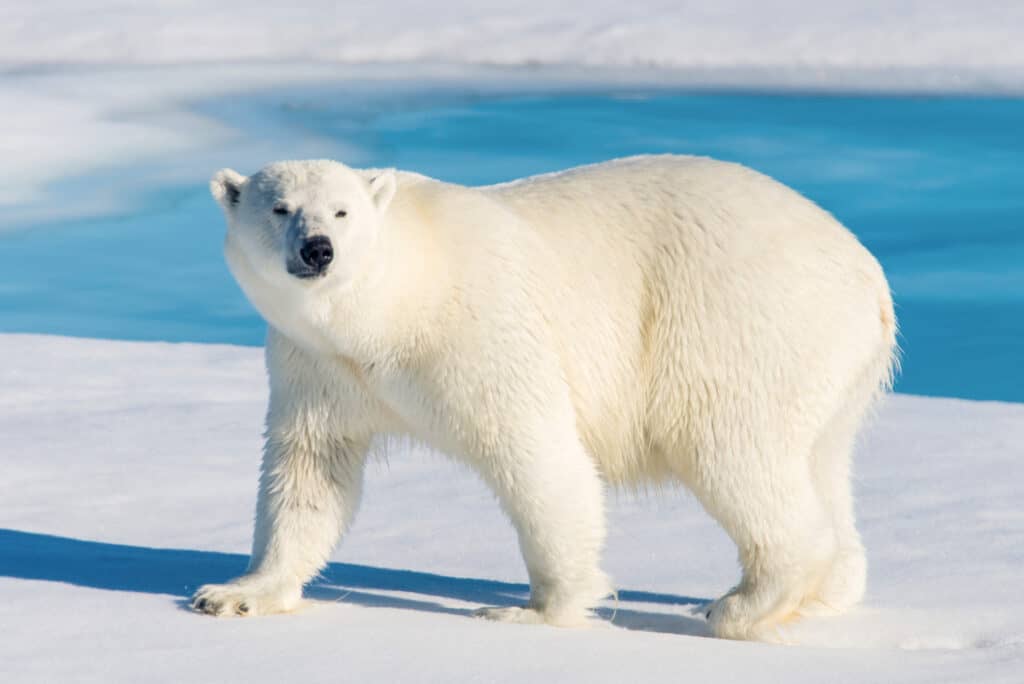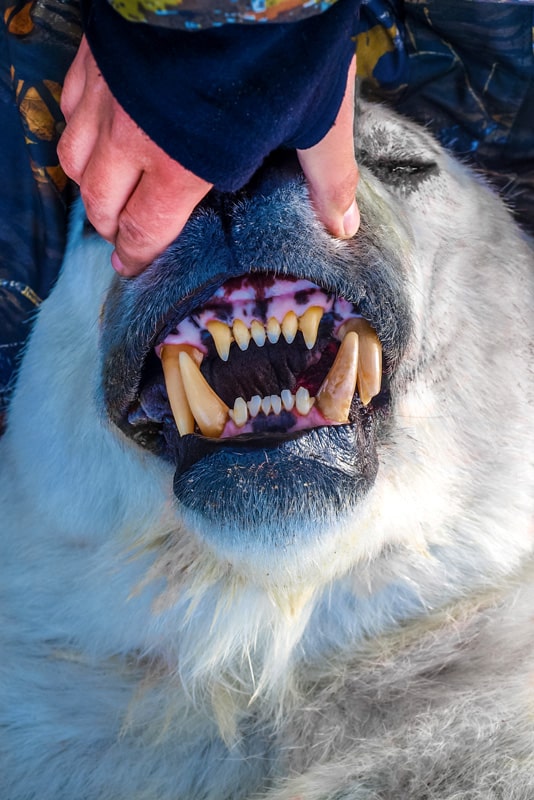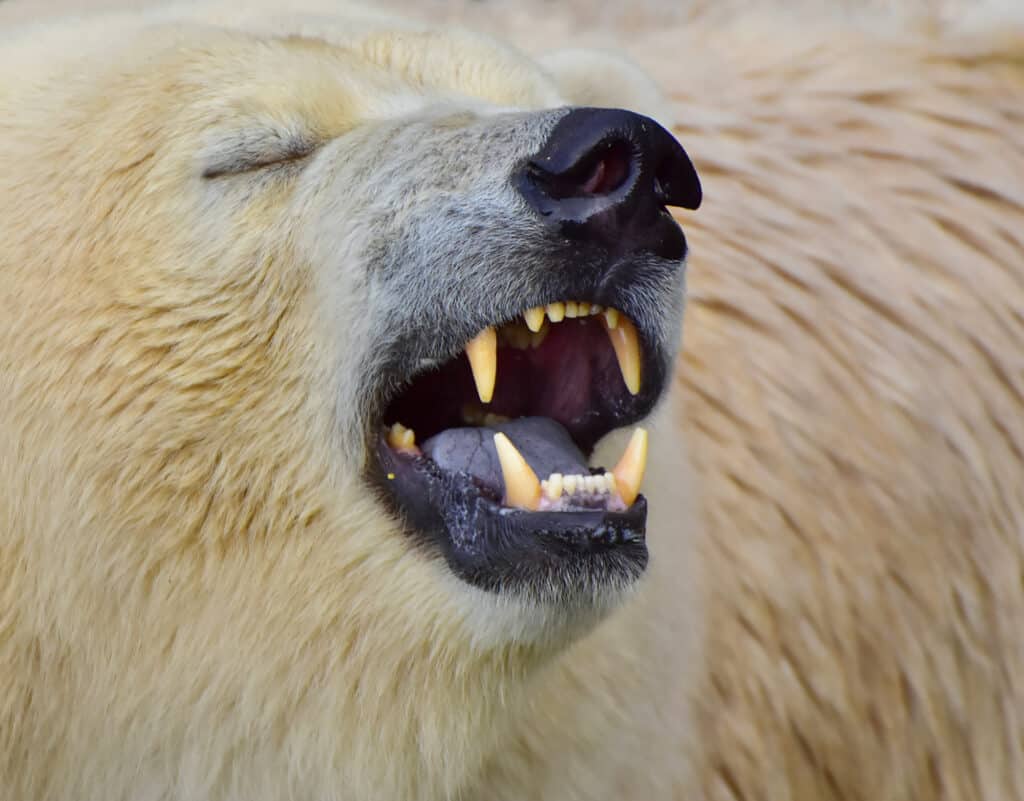The Arctic Ocean’s ice fields are home to the polar bear, the largest bear species in the world aside from the Kodiak brown bears found in Alaska. Although these animals are closely related to brown bears, their name literally translates as “sea bear.” The reason for this name is because of their choice of habitat. These bears have been seen as far as 100 miles from the nearest ice slate or even land. It is amazing to note that despite their size, they are also very skilled swimmers.
Although the representation polar bears receive shows them to be cute and cuddly. Like other bears, polar bears are very far from being cuddly animals. These bears are, to some extent, very dangerous; especially when they have their teeth out. Bears are dangerous predators due to their large size and weight in relation to their incredibly powerful bite. With their carnivorous habits and extensive diet, polar bears are no exception. Let’s examine polar bears’ teeth and every other crucial detail there is to learn about them.
How To Identify Polar Bears

An adult polar bear can weigh as much as half a tonne and grow as tall as two meters.
©iStock.com/Alexey_Seafarer
Polar bears are the largest terrestrial carnivores on the planet. An adult polar bear can weigh as much as half a tonne and grow as tall as two meters. In contrast to other bear species, polar bears appear to have white fur, but it’s noteworthy to notice that they actually have black skin and two layers of translucent, hollow fur. The polar bear is a large animal with a powerful physique. Its broad front paws are useful for paddling in the water, and the fur on the bottoms of its feet serves to keep the bear warm as well as provide more traction for moving about on the ice. They have far longer necks than other bear species, which allows them to swim with their heads still above the water.
What Type of Teeth Do Polar Bears Have?

Polar bears possess heterodont dentition.
©Igor Batenev/Shutterstock.com
Like other bears, polar bears are mammals. In fact, they are the only bear species that are classified as marine mammals. As such, like other mammals, polar bears have different teeth for different functions. In other words, polar bears possess typical carnivorous heterodont dentition. The polar bear’s heterodont dentition tells a lot about its feeding habits. This dentition is an anatomical explanation of teeth showing that the animal possesses more than one tooth morphology; showing they have teeth of different lengths and shapes.
How Many Teeth Do Polar Bears Have?

Polar bears have 42 teeth.
©cybercrisi/Shutterstock.com
Polar bears have 42 teeth. Like brown bears, polar bears have four different types of teeth – 10 molars, 16 premolars, 4 canines, and 12 incisors. Just because polar bears and brown bears have the same dentition does not imply that all other bears share this same dentition. The dentition of bears depends on their dietary habits as not all bears are fully carnivorous; some are omnivores.
While the incisors and canines, which are bigger teeth, are implanted rostrally inside the mouths of polar bears, the molars and premolars are fixed caudally. The teeth of polar bears have distinct purposes, and none of them are alike. If the bear loses a tooth during a fight, it may be quite problematic. A fractured tooth will likely have an impact on a polar bear’s eating habits.
Incisors
Polar bears use their 12 incisors to shear off pieces of blubber and flesh. The incisors of polar bears are arranged on both jaws, in between two long canines. There is a space between the canines and the two incisors closest to them, which are both sharper than the others. In polar bears, the incisors are attached to the premaxillary bone, and the premaxillary bone is attached to their upper jaw.
Molars
Like most other bears, polar bears have 10 molars, which are similar to those of other carnivorous animals, and even humans. Polar bears have molar teeth that are flat and are mainly used in chewing, and these teeth grow from the maxillae. Despite the similarities in functions, the polar bear’s molars are smaller and more angular than those of the brown bear.
Premolars
Polar bears have more premolars than any other type of teeth. Polar bear premolars are a true reflection of their predatory lifestyle because they are designed for tearing apart prey. Together with the molars, these premolars are classified as carnassials.
Canines
Polar bears have four canines, two on each jaw. One thing to note is just like the general size difference between male and female polar bears, there is also a difference in the size of their canines. Male polar bears possess larger and heavier canines than females. Generally, polar bears use their canines to grasp prey and tear tough hides. Polar bears also have a gap between their canine teeth and their rear molars, which is known as a diastema. This gap is perfect because it helps the bears easily grab their prey out of the water.
How Strong are Polar Bear Teeth?

Polar bears have a bite force of 1,200 PSI.
©Unicorn555/Shutterstock.com
Compared to how big they grow, bears have relatively small teeth. However, it would be a tragic misjudgment to underestimate how strong their teeth are or how hard they bite. Polar bear teeth can grow up to two inches long and have a bite force of about 1,200 PSI. They are the deadliest bears in the world because of their massive size, which also contributes to how powerful their bite is. Although most bears are omnivorous, the strength of their teeth still differs based on their preferred diet.
Up Next:
What Is The Bite Force Of A Polar Bear
The photo featured at the top of this post is © Zhiltsov Alexandr/Shutterstock.com
Sources
- ScienceDirect (1970) www.sciencedirect.com/topics/agricultural-and-biological-sciences/polar-bear
- Seaworld Parks & Entertainment (1970) www.seaworld.org/animals/all-about/polar-bear/characteristics/
- Misfit Animals, Available here: https://misfitanimals.com/bears/bear-teeth/
Thank you for reading! Have some feedback for us? Contact the AZ Animals editorial team.






